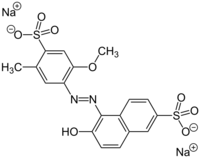| 誘惑紅 | |
|---|---|

| |
| IUPAC名 Disodium 6-hydroxy-5-[(2-methoxy-5-methyl-4-sulfonatophenyl)diazenyl]naphthalene-2-sulfonate | |
| 别名 | Disodium 6-hydroxy-5-[(2-methoxy-5-methyl-4-sulfophenyl)azo]-2-naphthalenesulfonate 2-Naphthalenesulfonic acid, 6-hydroxy-5-((2-methoxy-5-methyl-4-sulfophenyl)azo)-, disodium salt Food Red 17 C.I. 16035 FD&C紅色40號 E129 |
| 识别 | |
| CAS号 | 25956-17-6 |
| PubChem | 6093299 |
| ChemSpider | 11588224 |
| SMILES |
|
| InChI |
|
| InChIKey | CEZCCHQBSQPRMU-JGGVBICHBN |
| 性质 | |
| 化学式 | C18H14N2Na2O8S2 |
| 摩尔质量 | 496.42 g·mol−1 |
| 外观 | 紅色粉末 |
| 熔点 | 300 °C(573 K) |
| 危险性 | |
| NFPA 704 | |
| 若非注明,所有数据均出自标准状态(25 ℃,100 kPa)下。 | |
誘惑紅(Allura Red AC),是一種紅色偶氮染料,在美國又稱FD&C Red 40[1]。其作爲食用色素使用,E編碼爲E129。
它通常以紅色鈉鹽的形式提供,但也可用作鈣鹽和鉀鹽。 這些鹽可溶於水。在溶液中,其最大吸光度位於約504nm[2]:921。
作爲食物色素的應用
誘惑紅作爲染料在全球受到廣泛應用。在1980年,其年生產量達230萬公斤[3]。
歐盟批准誘惑紅作食物色素之用,但歐盟各國禁止食用色素的當地法律仍繼續保留[4]。在美國,美國食品藥品監督管理局(FDA)批准誘惑紅用於化妝品、藥物和食品中。 作爲色澱顏料時,稱爲红色40號麗基(Red 40 Lake)或红色40號鋁麗基(Red 40 Aluminum Lake)。誘惑紅在部分紋身染料中使用,亦應用在很多商品中,包括棉花糖、軟性飲料、櫻桃味製品、兒童藥物和奶製品。誘惑紅是至今在美國最常用的紅色染料,取代了對健康有負面影響的莧菜紅和赤蘚紅。
安全性


儘管北美和歐洲的食品安全組織進行了大量研究,安全性仍在廣泛使用中。
英國食品標準局(FSA)對六種食用染料(檸檬黃、誘惑紅、合成胭脂紅(或稱麗春紅4R)、喹啉黄、日落黄、氮紅)和一種防腐劑(苯甲酸钠)對兒童的影響進行研究。[5][6]研究發現「進食這些人工色素和防腐劑,與過度活躍的增加之間可能存在聯繫」[5][6]。諮詢委員會亦指出由於研究的局限性,結果尚未能推廣到一般人群,因此建議進一步測試[5]。
歐洲監管機構更加強調預防原則,要求爲色素加上標籤,並暫時減少其一日可接受攝取量(ADI); FSA呼籲食品製造商自願不使用色素[5][6]。然而,2009年歐洲食品安全局(EFSA)重新評估了手頭的數據,並確定「現有的科學證據並未證實色素與行為影響之間的聯繫」[5]。在進一步審查數據後,2014年,EFSA恢復了之前的ADI水平。[7]2015年,EFSA發現估計值中任何人群的ADI都不超過7 mg/kg[8]。
美國FDA在研究出版後沒有做出改變,但在2008年公共利益科学中心(CSPI)提交公民請願書,要求FDA禁止使用幾種食品添加劑之後,FDA重新審視了現有證據,但最終都沒有作出任何變更[5]。
誘惑紅曾在丹麥、比利時、法國、瑞士以及瑞典被禁止使用,直至其1994年加入歐盟[9]。挪威和冰島在1978至2001年間亦曾禁止其使用,該期間偶氮染料僅能合法用於酒精飲品和部分漁業產品[10]。
參見
參考文獻
- ^ From Shampoo to Cereal: Seeing to the Safety of Color Additives. [2008-06-04]. (原始内容存档于2008-01-15). Food Color Facts. [2006-08-18]. (原始内容存档于2007-10-01).
- ^ Zvi Rappoport (编). The Chemistry of Phenols. Chichester: John Wiley & Sons. 2004. ISBN 9780470869451.
- ^ Sharma, Vinita; McKone, Harold T.; Markow, Peter G. A Global Perspective on the History, Use, and Identification of Synthetic Food Dyes. Journal of Chemical Education. 2011, 88: 24–28. doi:10.1021/ed100545v.
- ^ European Parliament and Council Directive 94/36/EC of 30 June 1994 on colours for use in foodstuffs
- ^ 5.0 5.1 5.2 5.3 5.4 5.5 FDA. Background Document for the Food Advisory Committee: Certified Color Additives in Food and Possible Association with Attention Deficit Hyperactivity Disorder in Children: March 30-31, 2011 (页面存档备份,存于互联网档案馆)
- ^ 6.0 6.1 6.2 Sarah Chapman of Chapman Technologies on behalf of Food Standards Agency in Scotland. March 2011 [Guidelines on approaches to the replacement of Tartrazine, Allura Red, Ponceau 4R, Quinoline Yellow, Sunset Yellow and Carmoisine in food and beverages]
- ^ EFSA Panel on Food Additives and Nutrient Sources added to food (ANS) Reconsideration of the temporary ADI and refined exposure assessment for Sunset Yellow FCF (E 110) (页面存档备份,存于互联网档案馆) EFSA Journal 2014;12(7):3765 . doi:10.2903/j.efsa.2014.3765
- ^ Refined exposure assessment for Allura Red AC (E 129) | European Food. Efsa.europa.eu. [2018-09-08]. (原始内容存档于2021-01-17).
- ^ "E129 (页面存档备份,存于互联网档案馆)", UK Food Guide, a British food additives website. Last retrieved 20 May 2007.
- ^ Norwegian Food Safety Authority. [2007-07-09]. (原始内容存档于2012-08-04).









